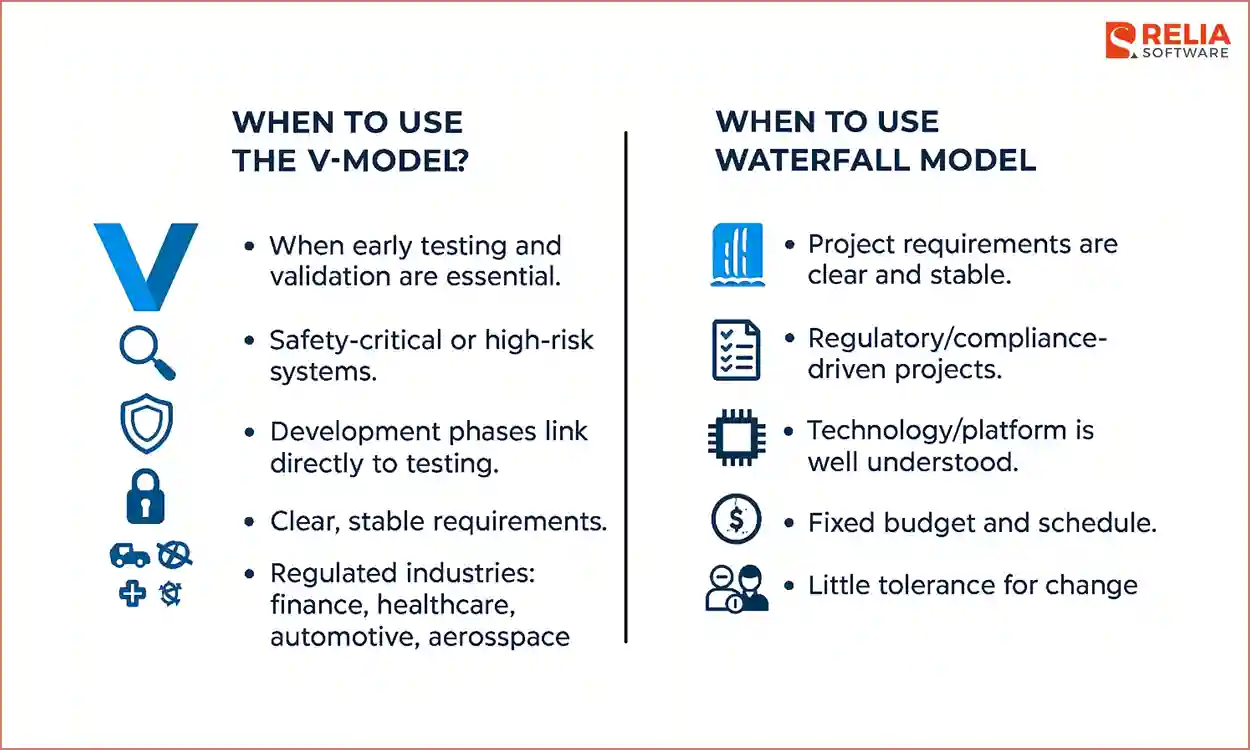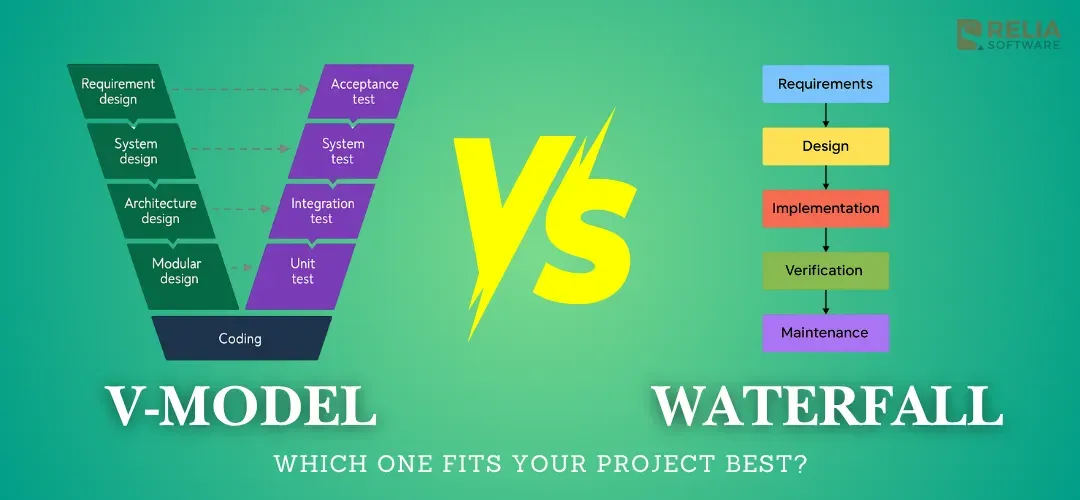When comparing traditional software development methods, V-model vs Waterfall is one of the most common discussions. Both follow a clear step-by-step process, but the key difference is in testing: V-model checks and validates at each development stage, while the Waterfall model waits until the end phase. This single change affects quality, cost, and project flexibility in very different ways.
In this blog, we’ll take a closer look at V-model vs Waterfall, showing how each works, what makes them different, and when to use them. Before exploring detailed differences, let’s have a look at this table comparison overview.
Dimension | V-Model | Waterfall |
Definition | Approach with parallel development and testing | A step-by-step process from development to maintenance |
Structure | “V”-shaped framework: verification & validation. | Linear sequence of phases |
Flexibility | Slightly flexible through early testing feedback, but still sequential. | Very rigid; changes require reworking earlier stages. |
Testing | Testing begins alongside development Verification and validation occur at each stage. | Testing starts only after development is complete. |
Risk Management | Continuous verification reveals risks early and allows proactive response. | Risks mainly identified at the start; later detection increases project risk. |
Cost of Change | Lower, due to early error detection and validation. | Higher, late testing makes fixes expensive. |
Stakeholder Involvement | Regular involvement during validation phases for feedback and sign-off. | Limited to initial requirements and final delivery. |
Best for | Ideal for large, regulated, or safety-critical systems requiring documentation and traceability. | Better for small, stable projects with predictable requirements. |
Documentation Burden | Heavy documentation with added traceability and test-mapping records. | Significant documentation, but simpler than V-Model’s paired verification sets. |
Definition
The V-Model is a software development approach that represents development and testing activities as two arms of a 'V' shape, with development steps on the left and testing methods on the right. This method emphasizes parallel development and testing to find defects early and ensure quality.
Meanwhile, Waterfall Model is a step-by-step process in which each development phase must finish before the next phase begins. This method is structured and simple to plan but hard to change once started.
Model Structure
At the core, the V-Model and Waterfall differ in how they organize development and testing. The V-Model uses a “V” shape, where each step on the left, like requirements or design, matches a testing step on the right. For example, requirements connect to acceptance tests, and design connects to system tests. This setup lets teams plan tests early and confirm progress as they go, reducing the chance of unexpected cases.
The Waterfall Model, however, follows a straight sequence from requirements to design, implementation, testing, and maintenance. Each phase must finish before the next begins, with no feedback loops between them.
Flexibility
Neither the V-Model nor the Waterfall is very flexible. However, the V-Model handles changes a little better than the Waterfall. Because testing is planned early, teams can find design or requirement issues sooner and fix them before coding starts.
The Waterfall Model is less likely to adapt to changes over time, so it could be costly and time-consuming. If requirements change after design or coding, teams often have to redo earlier work. This strict process slows progress and increases risk.
Testing Approach
V-Model finds defects much earlier than the Waterfall model, giving it a clear advantage in preventing major errors before release.
In the V-Model, testing is built into every stage; each step is checked as development moves forward, and the final product is validated against the original requirements. Waterfall Model, on the other hand, testing starts only after coding is finished. As a result, most problems appear late, when fixes are harder and more expensive.
>> Read more:
- What are 4 Levels Of Testing In Software Testing? With Examples
- Mastering Functional Testing for Delivering Bug-Free Software
- What is Unit Testing? Definition, Benefits & Process
Risk Management
V-Model controls risk better than the Waterfall one. Validation and verification happen at every step, helping teams find design or requirement issues early. Each phase also includes checks to keep the project on track and avoid major problems later. This constant review helps manage risks before they become serious.
Meanwhile, in the Waterfall Model, most risk analysis happens only at the beginning. Once development starts, new risks often go unnoticed until the testing phase at the end of the development process.
Cost
V-Model can save cost by catching issues before they spread to later phases, keeping rework smaller and more manageable. With verification steps in each stage, teams can lower the total cost of correction and control budgets more effectively, especially in large projects where errors can quickly multiply.
In contrast, the Waterfall Model can be more expensive than the V-model. It conducts testing near the end of the development process, so most issues appear only after the full system is built. Fixing them at that point could mean redesigning, recoding, and retesting, which slows progress and raises costs.
>> Read more: 14 Strategies Help Businesses Reduce Software Development Costs
Stakeholder Involvement
V-Model encourages stakeholders to take part during validation stages, reviewing results as each test confirms the project’s requirements. This regular feedback helps them see progress clearly and ensures the final product matches their expectations.
In the Waterfall Model, stakeholders are involved mainly at the start and end, first to define requirements and later to review the finished product. The long gap between these points can lead to confusion or unmet expectations discovered too late to fix.
Documentation Burden
Both models depend heavily on documentation, but they handle it differently. The V-Model creates more records during development, such as requirement lists, test plans, verification reports, and traceability logs that link each function to its test. This detailed tracking helps ensure full coverage and accountability.
The Waterfall Model also uses detailed documents, but with fewer testing files. Most of its paperwork focuses on design, coding, and final testing results rather than full traceability. This makes Waterfall stay simpler and faster for teams that don’t need deep documentation.
When To Use the V-Model?
The V-Model works best in projects that require accuracy, traceability, and strong control over quality. Because every phase has a matching test stage, this approach ensures that requirements are met exactly as planned and reduces the risk of major rework later.
For more details, you should use the V-Model in projects:
- When early testing and validation are essential.
- Include safety-critical or high-risk systems that require formal verification and documentation.
- When each development phase can be directly linked to a testing phase.
- With clear, stable requirements and a limited scope for change.
- In regulated industries such as finance, healthcare, automotive, and aerospace.
When To Use Waterfall Model?
The Waterfall Model is best for projects where everything is clear from the start and changes are unlikely. It works well when teams know exactly what needs to be built and can follow a fixed plan from beginning to end.
You should use the Waterfall Model:
- When project requirements are clear and stable from the beginning.
- For regulatory or compliance-driven projects that require strict documentation.
- When the technology or platform is well-understood by the team.
- If the project has a fixed budget and schedule that must be followed.
- When there is little tolerance for change, once development has started.

FAQs
1. Is the V-Model more expensive than Waterfall?
Not always. The V-Model costs more upfront for testing and documentation, but often saves money by finding issues early.
2. Can small teams use the V-Model?
Yes, if the project has clear requirements and needs strict quality checks. For flexible or small tasks, Waterfall may be simpler.
3. What if requirements change mid-project?
Both models handle change poorly. The V-Model can spot issues sooner, but any change still causes rework.
4. Which model is faster?
Waterfall is faster when everything goes smoothly. The V-Model takes longer but delivers better-tested results.
>> Read more:
- Agile vs Waterfall Methodology: Which One is Better?
- Spiral Model vs Waterfall Model: Which Approach to Choose?
- Lean vs Agile: Choosing the Right Approach for Software Projects
- DevOps vs Agile: What’s the Difference & How They Combine?
Conclusion
The V-Model and Waterfall Model both offer structured ways to manage software projects, but they serve different goals. The V-Model emphasizes early testing for better accuracy, while the Waterfall Model follows a simple flow suited to clear, fixed requirements. The right choice depends on your project’s goals: use the V-Model when accuracy matters most, and Waterfall when stability and simplicity are the priority.
>>> Follow and Contact Relia Software for more information!
- development
- web development

